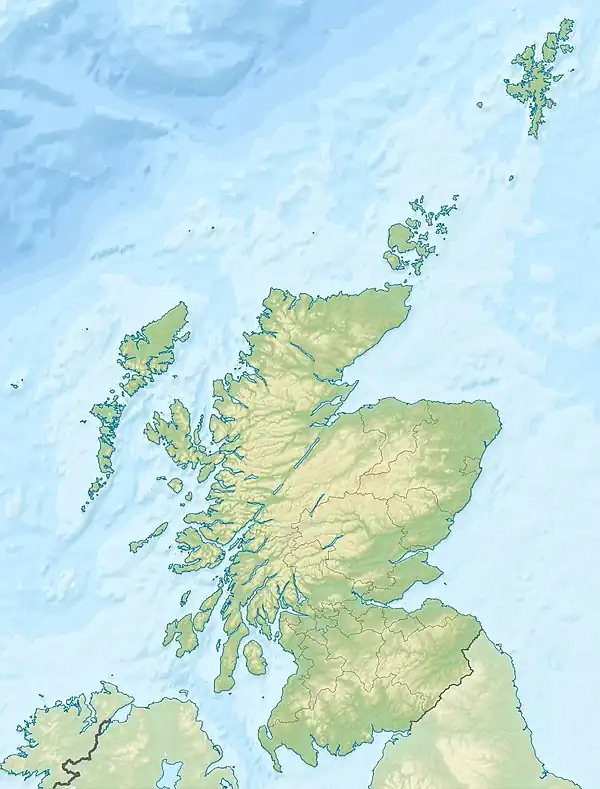Glendoe Hydro Scheme
The Glendoe Hydro Scheme for the generation of hydro-electric power is located near Fort Augustus, above Loch Ness in the Highlands of Scotland.
| Glendoe Reservoir | |
|---|---|
 | |
 Location of Glendoe Reservoir in Scotland | |
| Official name | Glendoe Hydro Scheme |
| Country | United Kingdom |
| Location | Scottish Highlands |
| Coordinates | 57.093°N 4.556°W |
| Opening date | 29 June 2009 |
| Owner(s) | Scottish and Southern Energy |
| Dam and spillways | |
| Height | 35 m (115 ft) |
| Length | 905 m (2,969 ft) |
| Reservoir | |
| Catchment area |
|
| Maximum length | 2 km (1.2 mi) |
| Normal elevation | 630 m (2,070 ft) |
| Power Station | |
| Installed capacity | 100 MW (max. planned) |
The scheme is operated by Scottish and Southern Energy (SSE) and was opened on 29 June 2009 by Queen Elizabeth, accompanied by the Duke of Edinburgh.[1]
Scheme details
Glendoe has a hydraulic head of 600 m (2,000 ft), the highest of any hydro-electric scheme in the United Kingdom,[2] and is thus ideally suited to generating large amounts of energy from the stored water in the reservoir, especially when combined with the relatively high annual rainfall in the area of around 2,000 mm (79 in). The Andritz six-jet vertical-axis Pelton turbine at Glendoe[3] is capable of generating up to 100 MW, with a peak flow of 18.6 m3/s (660 cu ft/s).
It is the largest of Scotland's recent civil engineering projects, with Hochtief as the design and build contractor. The scheme is predicted to produce about 180 GWh[4] of electricity per year, enough to provide approximately 5% of the electricity consumption of the city of Glasgow.[5][6] This gives an overall load factor of approximately 20%.
The immediate catchment of 15 km2 (5.8 sq mi) is supplemented by a further 60 km2 (23 sq mi) connected to the scheme by an underground network of pipes and tunnels, and this is fed into the reservoir on the upper reaches of the River Tarff. The dam, a 905-metre-long (2,969 ft) concrete-faced rock-filled embankment reaching a height of 35 m (115 ft) above the valley floor, is hidden from view from all current houses and public roads in the area.[7]
The scheme includes a number of tunnels. An 8.6-kilometre-long (5.3 mi) tunnel brings water from diversion intakes to the reservoir. An 8-kilometre-long (5.0 mi) tunnel, 5 metres (16 ft) in diameter, carries the water to the turbine and out into Loch Ness. This was excavated by a 220-metre-long (720 ft) tunnel boring machine (TBM) that was named "Eliza Jane" after a competition for local schoolchildren.[8]
The power station itself, 2 km (1.2 mi) from Loch Ness and containing the turbine and generator units, is housed in a large cavern a quarter of a kilometre below the hillside, adjacent to a smaller cavern containing the main transformer. These caverns are accessed via a 1.3-kilometre-long (0.81 mi) tunnel from the B862 road above Fort Augustus.
Station shutdown
In August 2009 the station was shut down and the power tunnel drained because of internal rock falls near the head of the tunnel.[9] Although the equipment in the power station was not affected, Glendoe was unable to generate power until repairs were made. SSE reported that electricity generation was unlikely to proceed until well into 2012.[10] The repairs involved construction of a bypass tunnel and a downstream access tunnel.[11] The contract for the repair work was awarded to BAM Nuttall. SSE issued proceedings seeking to recover £130 million in repair and reinstatement costs and £65 million in alleged loss of profit from Hochtief, who constructed the original tunnel, but in a Judgment (Opinion) published in December 2016 Hochtief was held by the Scottish Court of Session not to have been liable for the collapse. In an appeal decided in 2018, SSE were awarded more than £107 million in compensation. The judges hearing the appeal split 2–1 in SSE's favour.[12]
Energy generation at the scheme restarted in August 2012.[13]
References
- "Huge hydro-electric scheme opens". BBC News. British Broadcasting Corporation. 29 June 2009. Retrieved 11 November 2009.
- "Project Overview". Scottish and Southern Energy. Archived from the original on 25 October 2009. Retrieved 11 November 2009.
- "Glendoe returns". Water Power Magazine. Retrieved 17 June 2013.
- "About Glendoe". SSE. Archived from the original on 19 June 2013. Retrieved 17 June 2013.
- "Behind the scenes at hydro scheme". BBC. 29 June 2009. Retrieved 11 November 2009.
- "How much hydro to power Glasgow". 7 January 2008.
- "Reservoir and Dam Information". Scottish and Southern Energy. Archived from the original on 9 October 2009. Retrieved 11 November 2009.
- "Loch Ness Hydro Tunnel Makes Breakthrough". Retrieved 17 June 2013.
- "Generation suspended". SSE. Archived from the original on 9 December 2008. Retrieved 11 November 2009.
- "Glendoe out of action until 2011". BBC. 11 November 2009. Retrieved 11 November 2009.
- "Glendoe repair bulletin - Issue 5 - Summer 2011". SSE. Archived from the original on 8 June 2012. Retrieved 29 September 2011.
- "SSE Generation wins claim over Glendoe tunnel collapse". BBC News Online. 10 April 2018. Retrieved 11 April 2018.
- "Glendoe hydro electric scheme resumes operations". BBC. 29 August 2012. Retrieved 13 September 2012.
Further reading
- Wynne, Alexandra (21 January 2010). "Tunnel repairs to begin on disaster-struck hydro scheme". New Civil Engineer. London: EMAP International.